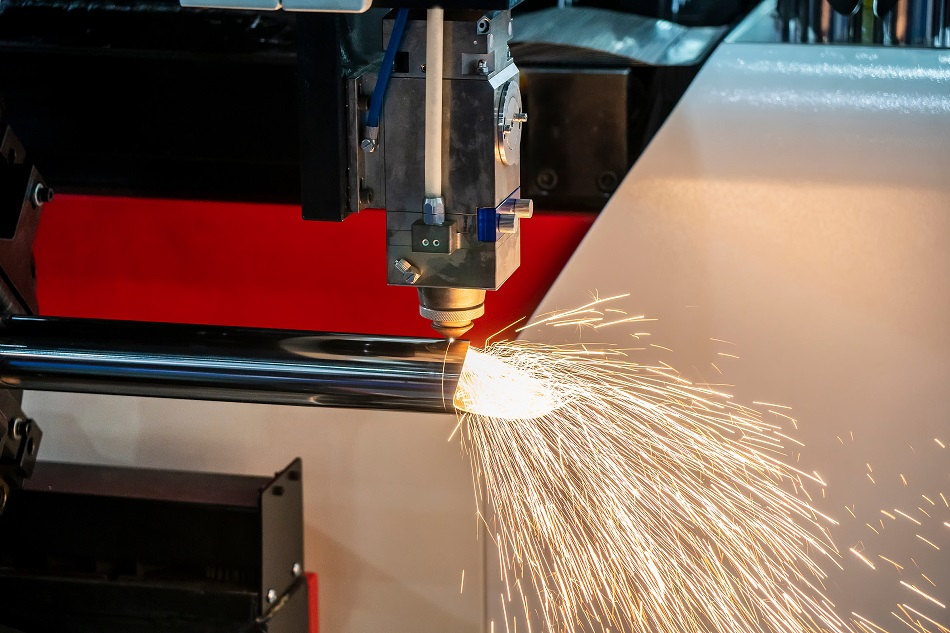
Image Credit: Pixel B/Shutterstock.com
Simpler to use and often considered to be more reliable than conventional carbon dioxide (CO2) laser technology, fiber lasers are highly precise, produce a high-quality beam, and can be used to create intricate mechanical parts.
Industrial manufacturers have started to embrace the various benefits of automating these fiber laser processes.
For many, automated fiber-laser capability has become a necessity, as companies feel pressure to have the latest production technology. Organizations that do not adopt the latest technology run the risk of losing business to competing entities that have faster, more efficient processes.
An automated fiber laser system is used for high-volume part creation and high-quality part cutting from relatively thin sheet metal. A fiber laser operates most effectively when the material to be cut is less than 4 mm in width.
The results process is faster and more affordable than using CO2 lasers, with a quality that is unrivaled. An automated laser can operate with no assistance for hours and can be left to function overnight.
The fundamental benefit that comes with automation is not having to use manual labor to load sheets of material and unload cut material, making it highly conducive to bigger jobs.
These systems feature low operating costs as a result of low energy and resource demands. Automated laser systems can function unmonitored which can reduce overtime.
In comparison, a typical CNC machine must be operated for 30 minutes to make a part, but an automated fiber laser can make the same part, unattended in just 10 minutes.
Useful in many different operations, automated fiber lasers can help to address typical production issues. For example, a business that makes industrial parts may be trying to find a basic solution to load and unload stacks of uniform material, while a different company may want to load multiple different material types with different thicknesses.
These demands can be too much to handle for a contract business with dozens of clients. Equipment manufacturers have a different set of issues, including product modifications and prototyping. For all of these issues, automated fiber lasers are the ideal solution.
Automation allows part makers to cut products as rapidly as they stamp them which eliminates many issues that are related to tooling. Stampers usually do not perform well with secondary operations, but the addition of an automated fiber laser system has been proven to cut lead times.
When establishing if an automated fiber laser is a right choice for a particular production setting, it is essential to look beyond the primary advantage of heightened generation. This production solution has a range of benefits, can offer dependable efficiency, and has a considerable return on investment.
The Safer Option
Dropped efficiency and workplace injuries cost companies billions of dollars annually. Decreased material handling can significantly decrease the risk of injury, as large and challenging sheets of material have many inherent dangers.
A safer workplace not only means less injury. It also translates to lower turnover, as employees recognize that their employer is making a significant investment in their wellbeing.
Easy Adoption
The current state of the technology allows for relatively easy adoption and transition process. Most automated fiber laser systems are simply designed and easy to use.
While no two production operations are the same, these systems are durable and adaptable. They are capable of handling the majority of material handling requirements.
Manufacturers often find success in having their automated fiber laser system handle the majority of their production while using manual techniques to handle smaller and more complex production jobs.
Easy Maintenance and Service
Manufacturers understand that the major considerations before any purchase are service and maintenance requirements.
Most automated fiber laser systems have parts in common and the parts are widely available. This leads to less downtime, less pressure associated with downtime, and high productivity.
Adaptability
With fiber lasers being as long as 50 feet, the footprint is a major concern. Automated systems are adaptable and can fit within a variety of production floor conditions and space requirements.
Sources and Further Reading
Disclaimer: The views expressed here are those of the author expressed in their private capacity and do not necessarily represent the views of AZoM.com Limited T/A AZoNetwork the owner and operator of this website. This disclaimer forms part of the Terms and conditions of use of this website.